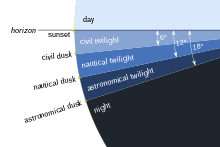Sunset
Sunset, also known as sundown, is the daily disappearance of the Sun below the horizon due to Earth's rotation. As viewed from everywhere on Earth (except the North and South poles), the equinox Sun sets due west at the moment of both the Spring and Autumn equinox. As viewed from the Northern Hemisphere, the sun sets to the northwest (or not at all) in the Northern hemisphere's spring and summer, and to the southwest in the autumn and winter; these seasons are reversed for the Southern Hemisphere.
The time of sunset is defined in astronomy as the moment when the upper limb of the Sun disappears below the horizon.[1] Near the horizon, atmospheric refraction causes sunlight rays to be distorted to such an extent that geometrically the solar disk is already about one diameter below the horizon when a sunset is observed.
Sunset is distinct from twilight, which is divided into three stages. The first one is civil twilight, which begins once the Sun has disappeared below the horizon, and continues until it descends to 6 degrees below the horizon. The second phase is nautical twilight, between 6 and 12 degrees below the horizon. As for the third one, it is astronomical twilight, which is the period when the Sun is between 12 and 18 degrees below the horizon.[2] Dusk is at the very end of astronomical twilight, and is the darkest moment of twilight just before night.[3] Finally, night occurs when the Sun reaches 18 degrees below the horizon and no longer illuminates the sky.[4]
Locations further North than the Arctic Circle and further South than the Antarctic Circle experience no full sunset or sunrise on at least one day of the year, when the polar day or the polar night persists continuously for 24 hours.
The time of sunset varies throughout the year, and is determined by the viewer's position on Earth, specified by latitude and longitude, altitude, and time zone. Small daily changes and noticeable semi-annual changes in the timing of sunsets are driven by the axial tilt of Earth, daily rotation of the Earth, the planet's movement in its annual elliptical orbit around the Sun, and the Earth and Moon's paired revolutions around each other. During Winter and Spring, the days get longer and sunsets occur later every day until the day of the latest sunset, which occurs after the summer solstice. In the Northern Hemisphere, the latest sunset occurs late in June or in early July, but not on the Summer solstice of June 21. This date depends on the viewer's latitude (connected with the Earth's slower movement around the aphelion around July 4). Likewise, the earliest sunset does not occur on the winter solstice, but rather about two weeks earlier, again depending on the viewer's latitude. In the Northern Hemisphere, it occurs in early December or late November (influenced by the Earth's faster movement near its perihelion, which occurs around January 3).[citation needed]
Likewise, the same phenomenon exists in the Southern Hemisphere, but with the respective dates reversed, with the earliest sunsets occurring some time before June 21 in winter, and latest sunsets occurring some time after December 21 in summer, again depending on one's southern latitude. For a few weeks surrounding both solstices, both sunrise and sunset get slightly later each day. Even on the equator, sunrise and sunset shift several minutes back and forth through the year, along with solar noon. These effects are plotted by an analemma.[5][6]








